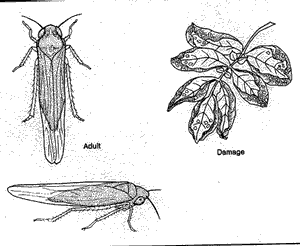Vulnerable Plants
Leafhoppers are particularly problematic for tomatoes, beets, and potatoes. they can sometimes be found bothering ornamentals such as Marigolds.
 |
Leafhoppers may be green, brown, or yellow, and often have colorful markings. They are 1/4 to 1/3 inch long. Their wedge-shaped wings are held in a roof-like position over their bodies. They have long hind legs that allow them to hop like a grasshopper, and they have very powerful wings that allow them to fly quickly. Adults and nymphs walk backward and sideways as well as they walk forward. The leafhopper feeds on the underside of the leaves of a plant.
Nymphs are similar to adults, except for smaller size and a lack of wings.
Some species spread virus diseases such as aster yellows.
Life cycles of leafhoppers vary, some over-wintering as eggs, others as adults. The pests lay eggs on leaf undersides of garden plants and nearby perennial weeds. Leafhoppers occur throughout the United States.
Emergence time - Nymphs appear in early spring.
Symptoms of Leafhoppers
 |
Nymphs and adults suck juices from plant leaves, buds, and stems. They pierce tissue on the undersides of the leaves, sucking sap and removing chlorophyll from the cells. Plants weaken. The foliage may be covered with white or yellow mottling and may drop. The large amounts of honeydew excreted by leafhoppers gives plants a glazed appearance. Ants may be present to eat the honeydew. Black sooty mold may grow on this honeydew.
During the process of feeding, the hoppers inject a toxin that causes "hopper burn" This malady is characterized by a yellowing of the tissue at the tip and margin of leaves. Damage can cause the leaf to eventually scorch and drop from the plant.

